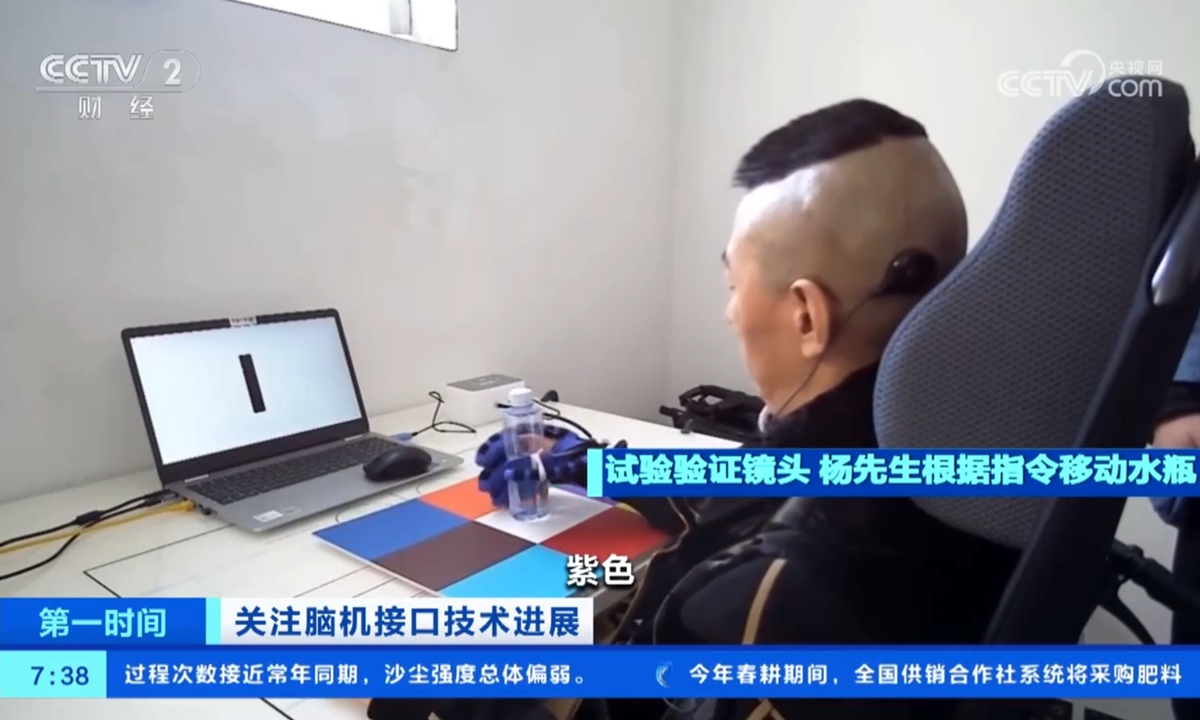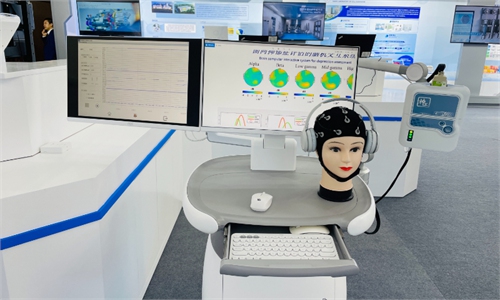Major advancement in China’s brain-computer interface technology: paralyzed patient of 14 years now able to drink water through thought-controlled movement

Photo: CCTV
A research team at Tsinghua University recently unveiled cases where two paralyzed patients achieved the control of objects and movement through wireless minimally invasive Brain-Computer Interface or BCI. One of the patients, who had been paralyzed for 14 years, successfully "drank water from a bottle using robotic hands" for the first time, the Chinese Central Television reported on Saturday.
In recent years, with the continuous development of BCI technology, scenarios that were once only found in science fiction have frequently appeared in our sight.
The first case is about the 35-year-old patient surnamed Bai who underwent wireless minimally invasive BCI implantation surgery last December.
After more than two months of rehabilitation training, he is now able to control cursor movement through thought. Doctors explained that through the BCI, neural signals from the brain's motor area can be identified, and the patient's movement intentions can be decoded, thereby achieving "thought-controlled activities."
Another patient is a man surnamed Yang, who has been paralyzed for 14 years. He underwent implantation surgery last October, marking China's first case of wireless minimally invasive BCI implantation surgery. Currently, Yang has had his gripping function partially restored by controlling an exoskeleton glove with his thoughts. On average, he can pick up a water bottle or object and place it in a designated position within 10 seconds.
Yang can effortlessly use brain signals to control a robotic hand and, for the first time since his paralysis, pick up a water bottle to drink on his own.
“As you think about it [picking up the water bottle], you can already grasp it. I feel very fortunate; this greatly improves my quality of life," Yang said. His wife is also very excited about this development and looks forward to Yang being able to independently complete more daily activities as technology advances.
Experts explain that the device implanted in Yang's head, which is only the size of a coin, incorporates a BCI processor, wireless communication and power interfaces, as well as electrodes for collecting brainwaves.
The implantation site is located on the outer side of the skull, with only the electrodes entering the skull and adhering to the outer surface of the dura mater. Additionally, this system includes information collection and power supply modules, brainwave decoding and translation modules, as well as a pneumatic glove exoskeleton.
There are two coils, one inside the patient's body and one outside. The outer coil can both supply power through the skin and transmit the brain signals from the patient's brain, achieving wireless power supply and communication. The collected signals are then used to control the pneumatic glove exoskeleton.
Experts explained that BCI devices are divided into three categories: non-invasive, invasive, and semi-invasive.
Non-invasive BCI collect brainwave signals through the scalp, offering the highest safety but with lower signal quality and limited functionality.
Invasive BCI involve directly implanting electrodes into the cerebral cortex, providing the highest quality neural signals, but they entail significant risk of trauma or other side effects for patients.
The wireless minimally invasive BCI developed by Tsinghua University is semi-invasive, involving the implantation of electrodes outside the patient's brain's dura mater. This approach does not damage neural tissue and allows for higher signal strength and resolution, while also reducing the risk of immune reactions and neuronal damage.
Currently, major countries around the world regard the future as the "era of neuroscience," and China initiated the brain initiative in 2017, in which brain-computer interfaces play a crucial role.
Academician of the Chinese Academy of Sciences and Academic Director of the Chinese Academy of Sciences Brain Intelligence Excellence Center, Pu Muming, detailed that BCI applications are currently mainly limited to medicine.
Most of the clinical trials conducted by global scientists on brain-computer interfaces are aimed at the functional recovery of paralyzed patients.
In this clinical trial, in addition to reading information from the brain's motor cortex, the collaborative team also specifically designed channels for recording sensory information from the brain. "Not only does it record information from the motor cortex, but it also records information from the sensory cortex, enabling the recording of feedback information," Pu said.
When the brain can receive feedback information from the executed actions, it forms a complete information loop for action thinking, greatly enhancing the effectiveness of brain-computer interface applications in the field of neurology.
The team's goal is to iteratively develop a universal minimally invasive brain-computer interface platform for the rehabilitation of more brain disorders such as epilepsy and cognitive impairment.
The Tsinghua University research team's wireless minimally invasive BCI technology involves placing multiple electrodes on the dura mater inside the skull. Although this area does not gather signals as effectively as inserting electrodes directly into brain cells, it does not cause damage to the brain cells, the Global Times learned.
"The thickness of a person's skull is between 6 millimeters and 1 centimeter, and even thicker at the sides and back of the skull, which is sufficient for embedding electrodes and processing chips. After the surgery, patients can quickly go home, making the wireless minimally invasive brain-computer technology more durable," said Hong Bo from the School of Medicine with Tsinghua University who leads the team.
Hong believes that the next goal is to strive to obtain the National Class III medical device license. The team is preparing for large-scale clinical trials and optimistically estimates that in about two years, the wireless minimally invasive BCI technology could obtain marketing authorization. This means that the brain-computer interface system will become a mature product that can be applied nationwide.
Once the technology is applied in a mature manner, the beneficiaries will not only be patients with high-level paralysis. Hong believed that this technology has applicable scenarios for patients with lower limb rehabilitation, spinal cord injuries, and even for patients with amyotrophic lateral sclerosis, depression, epilepsy, Alzheimer's disease, and more.
For example, for patients with amyotrophic lateral sclerosis, whose motor neurons in the limbs are nearly extinct, losing the ability to move and feel, connecting this brain-computer interface to the patient's motor cortex of the brain could control the cursor on a computer screen. In the future, a brain-controlled mouse and keyboard could be created for ALS patients, allowing them to type on a computer using BCI technology to write articles and communicate with others.
Including whether this technology can be used for language decoding in the future, we are conducting more precise research. The team has a lot of basic scientific research under its belt, and under the support of the National Natural Science Foundation and the Ministry of Science and Technology, we are trying to reveal how the human brain encodes mandarin speech and language, Hong told the Global Times.
Looking further ahead, BCI technology could not only aid disabled patients but also, more importantly, could become a significant step in the evolution of humanity. Human behavior represents one form of intelligence, characterized by flexibility and creativity, while machine behavior offers another form of intelligence, marked by precision and efficiency. “The fusion of the two will construct a future of limitless possibilities," Hong said.


